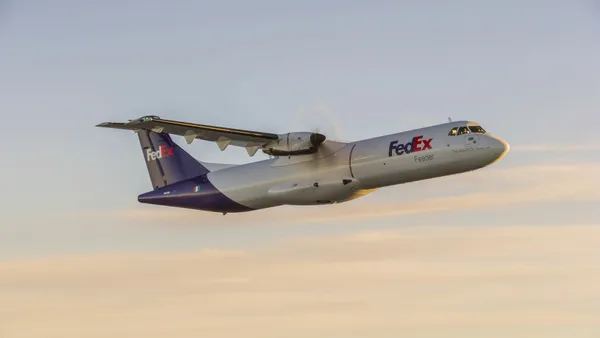Dive Brief:
- Demand for airfreight in July, as measured by chargeable weight, was flat compared to the same month in 2019 and up 23% over 2020, according to the latest figures from Clive. The 2019 comparison shows the demand has returned to pre-pandemic levels.
- Airfreight capacity is still 18% below its July 2019 level, though it has grown 29% compared to the same month in 2020.
- Rates from China are currently on the upswing at $8.10 per kilogram as of Monday, which is an almost 6% increase from a month ago and a nearly 61% increase YoY, according to the latest figures from the TAC Index.
Dive Insight:
The return of demand to the airfreight market has been good news for cargo airlines. But with the demand returning before capacity, tightness in the market is expected to remain, according to Clive Managing Director Niall van de Wouw.
"Compared to where the market was a year ago, performance on a par with July 2019 is certainly not bad news, but the demand vs. supply ratio is going to remain tight, especially with no signals that the inter-continental passenger market is going to recover anytime soon," van de Wouw said in a statement.
The lack of capacity in the airfreight market is still driven by the shortage of belly capacity in passenger airlines. And determining when that will return is hard to predict, according to Peter Stallion, the head of air and containers for Freight Investor Services.
"Anecdotally, it still remains very common that passenger schedules will effectively roll or cancel in reaction to actual demand for the flight," Stallion said in a market update earlier this month. "This makes the picture for trans-Atlantic prices very difficult to predict with any certainty."
But cargo airlines are also preparing for the industry's busy season with the holidays now less than four months away.
"In the fourth quarter, you would expect [it] is always going to be the highest quarter given the holiday period," Atlas Air CFO Spencer Schwartz said on the company's earnings call Monday.
Atlas Air CEO John Dietrich also underscored the imbalance in the market outlined by the Clive data.
"Demand also continues to exceed available supply, particularly on the international routes as international travel stays subdued and related belly capacity remains out of the market," Dietrich said. Atlas Air's volume has exceeded pre-pandemic levels, he said.
Air is not the only freight mode where supply is being outstripped by demand. Capacity in the ocean freight market is also too low for the current demand from cargo owners. This shortage of capacity on the ocean is pushing some shippers to the air, according to Dietrich.
"We are also seeing congestion and delays at many ocean ports worldwide," he said. "This congestion and the related delays are leading to ocean freight rates that are extremely elevated and shippers are, therefore, increasingly choosing air freight to mitigate bottlenecks in their supply chains, and that’s driving even more airfreight demand."














